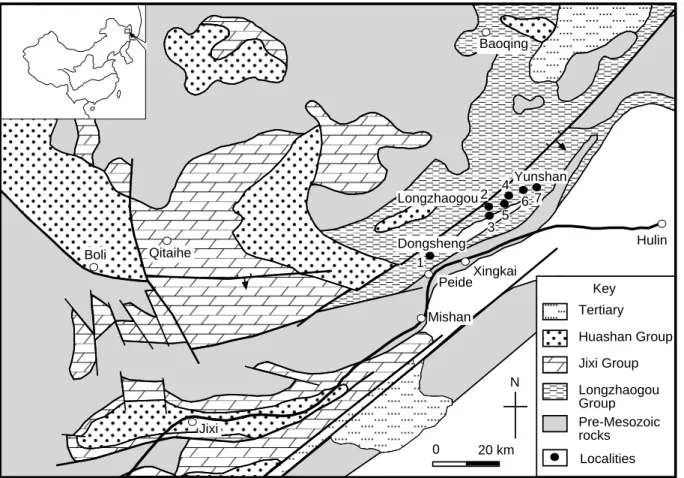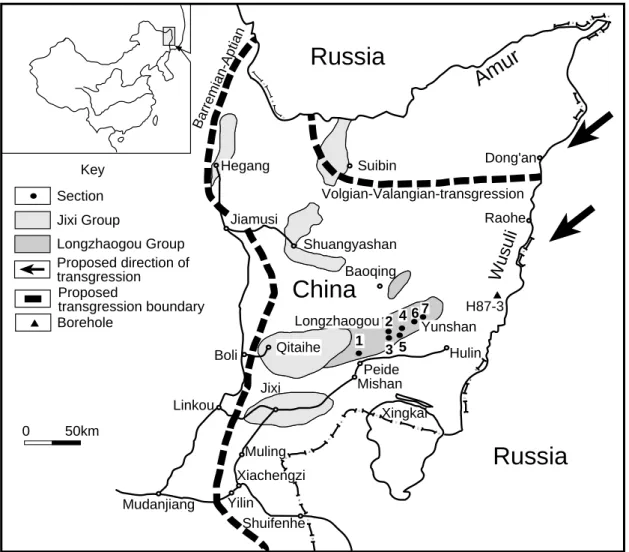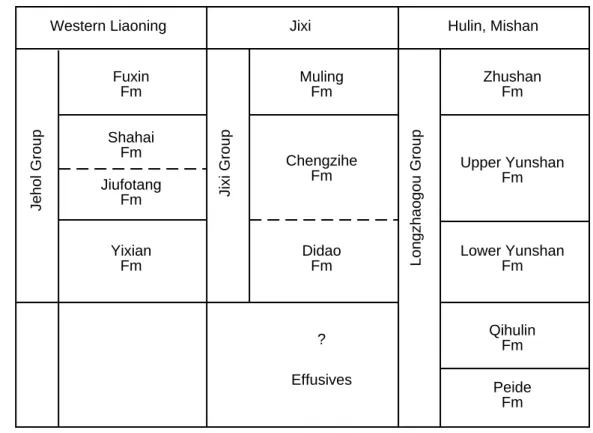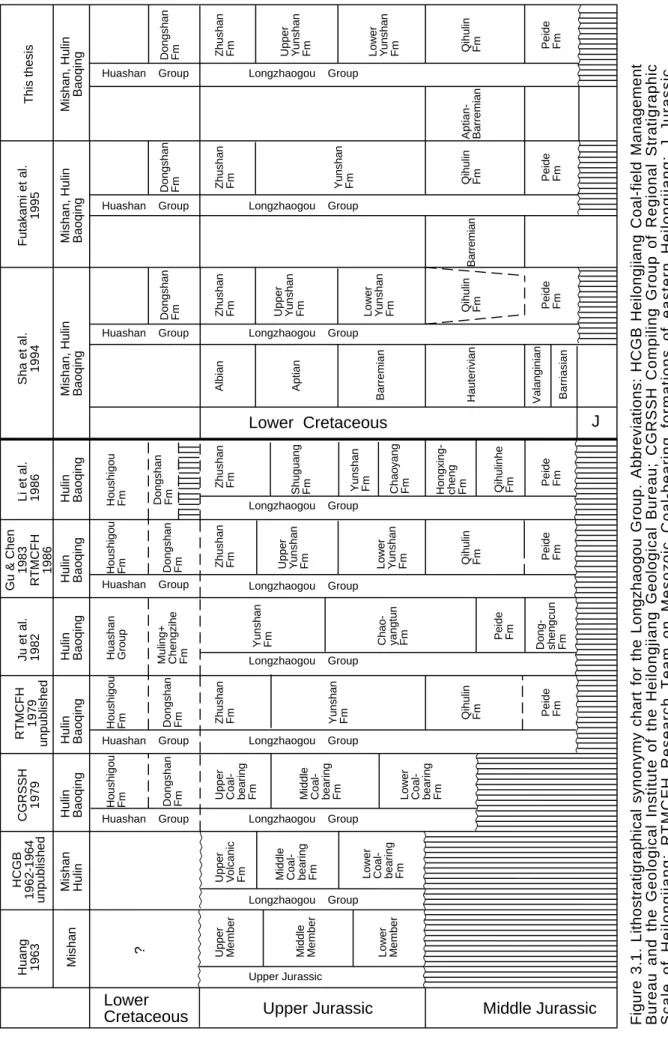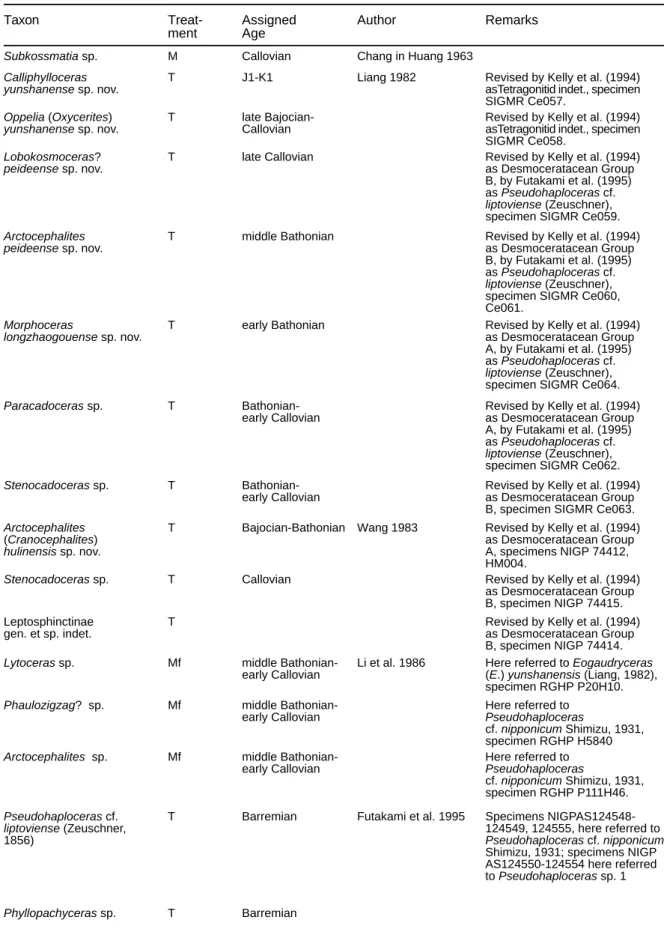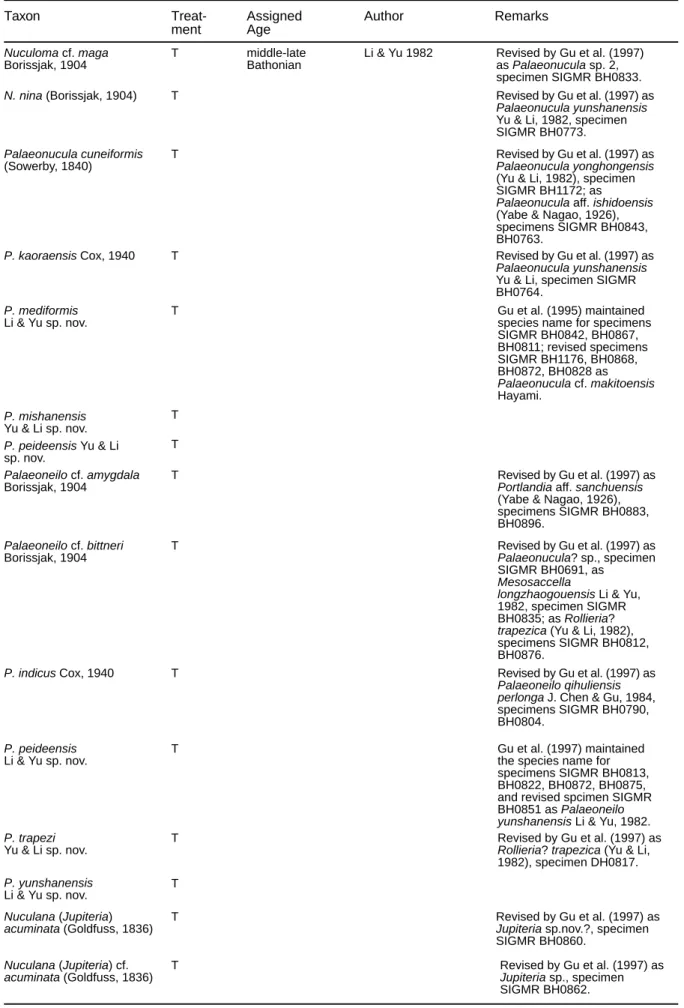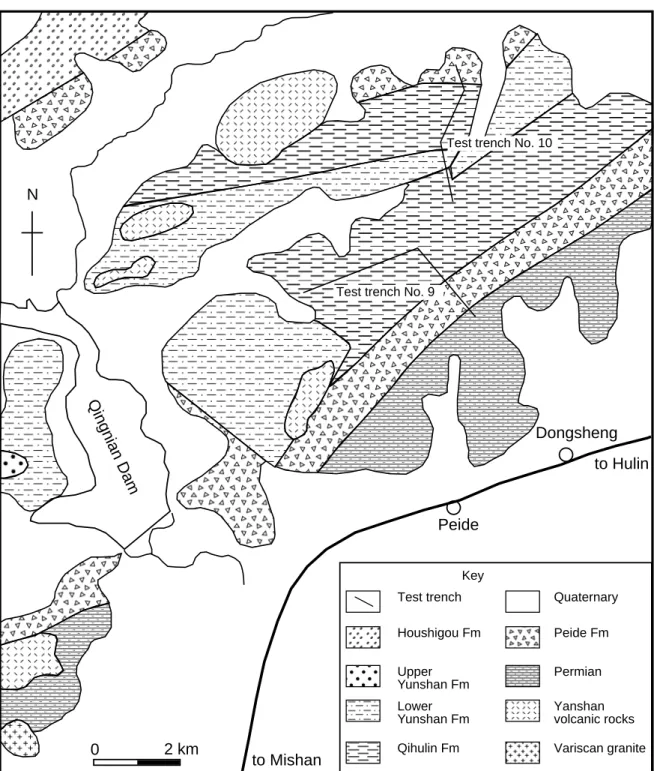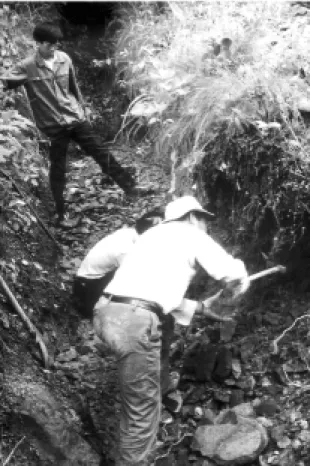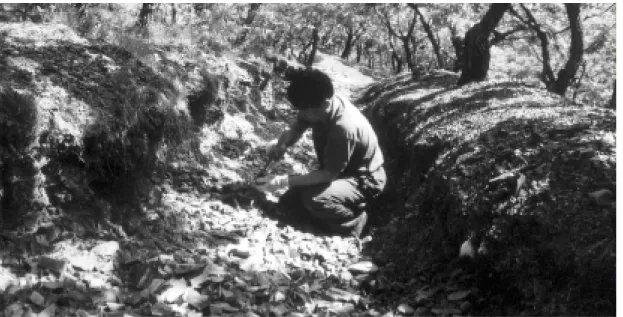Dissertation
Submitted to the
Combined Faculties for the Natural Sciences and for Mathematics of the Ruperto-Carola University of Heidelberg, Germany
for the degree of Doctor of Natural Sciences
presented by
Master of Science: Gang Li Born in: Heilongjiang, China Oral examination: 30 November 2001
Gedruckt mit Unterstützung des Deutschen Akademischen Austauschdienstes (Printed with the support of German Academic Exchange Service)
Palaeontology and biostratigraphy of the Lower Cretaceous Qihulin Formation in eastern Heilongjiang, northeastern China
Referees: Prof. Dr. Peter Bengtson Prof. Pei-ji Chen
This manuscript is produced only for examination as a doctoral dissertation and is not intended as a permanent scientific record. It is therefore not a publication in the sense of the International Code of Zoological Nomenclature.
Abstract
The purpose of the study was to provide conclusive evidence for a chronostratigraphical assignment of the Qihulin Formation of the Longzhaogou Group exposed in Mishan and Hulin counties of eastern Heilongjiang, northeastern China. To develop an integrated view of the formation, all collected fossil groups, i.e. the macrofossils (ammonites and bivalves) and microfossils (agglutinated foraminifers and radiolarians) have been studied. The low-diversity ammonite fauna consists of Pseudohaploceras Hyatt, 1900, and Eogaudryceras Spath, 1927, which indicate a Barremian–Aptian age. The bivalve fauna consists of eight genera and 16 species. The occurrence of Thracia rotundata (J. de C: Sowerby) suggests an Aptian age. The agglutinated foraminifers comprise ten genera and 16 species, including common Lower Cretaceous species such as Ammodiscus rotalarius Loeblich & Tappan, 1949, Cribrostomoides? nonioninoides (Reuss, 1836), Haplophragmoides concavus (Chapman, 1892), Trochommina depressa Lozo, 1944. The radiolarians comprise ten genera and 17 species, where Novixitus sp., Xitus cf. spicularius (Aliev, 1965), Archaeodictyomitra cf.
vulgaris Pessagno, 1977, Stichomitra cf. tosaensis Nakaseko & Nishimura, 1981 all indicate an Early Cretaceous age. Thus the Qihulin Formation is assigned to the Barremian–Aptian.
Key words: Barremian, Aptian, Qihulin Formation, Longzhaogou Group, Heilongjiang, China, ammonites, bivalves, agglutinated foraminifers, radiolarians.
Contents
1. Introduction... 1
2. Geological setting... 3
3. Previous work... 7
3.1. Lithostratigraphy. ... 7
3.2. Palaeontology and biostratigraphy ... 10
3.2.1. Ammonites ... 10
3.2.2. Bivalves... 12
3.2.3. Ostracods... 21
3.2.4. Brachiopods... 22
3.2.5.Gastropods... 22
3.2.6. Flora ... 23
4. Material and methods ... 25
4.1. Fieldwork ... 25
4.2. Material ... 25
4.3.Laboratory techniques ... 26
4.3.1. Microfossils... 26
4.3.2. Nannofossils ... 26
4.3.3. Palynomorphs and dinoflagellates... 27
5. Localities... 28
5.1. Dongsheng section... 29
5.2. Longzhaogou section ... 30
5.3. Section south of Qianjin village ... 32
5.4. Team No. 4 of Farm 850... 32
5.5. Chaoyang section... 32
5.6. Yunshan sections ... 33
6. Biostratigraphy ... 34
6.1. Ammonites ... 34
6.2. Bivalves... 34
6.3. Agglutinated foraminifers ... 35
6.4. Radiolarians... 35
7. Taxonomy ... 37
7.1. Ammonites ... 37
7.2. Bivalves... 47
7.3. Radiolarians... 70
7.4. Agglutinated foraminifers ... 85
8. Conclusions... 100
9. Acknowledgements ... 101
10. References... 102
11. Explanation of plates ... 116
12. Appendix... 124
12.1. Dongsheng section... 124
12.2. Longzhaogou section ... 124
12.3. Chaoyang section... 125
12.4. Yunshan sections ... 125
Résumé ... 128
1. Introduction 1
1. Introduction
0 20 km
N
Hulin
Tertiary Huashan Group Jixi Group Longzhaogou Group Pre-Mesozoic rocks
Key
Localities Boli Qitaihe
Mishan Peide
Baoqing
Yunshan Longzhaogou
Jixi
Dongsheng 1
2 3
4 5
6 7
Xingkai
Figure 1.1. Simplified geological map of the Jixi and Hulin areas, eastern Heilongjiang, China (based on data from the Research team on the Mesozoic coal-bearing formations in eastern Heilongjiang, 1986). 1. Dongsheng village. 2. Longzhaogou valley. 3. South of Qianjin village. 4. Chaoyang village. 5. Team No. 4 of Farm 850. 6. Test trench No. 1 of Yunshan Farm. 7. Test trench No. 2 of Yunshan Farm.
In the eastern part of Heilongjiang Province, a succession of Lower Cretaceous coal- bearing, alternating marine and nonmarine rocks is exposed. It comprises the Jixi Group in the west and the Longzhaogou Group in the east (figure 1.1). Geologists and palaeontologists have extensively studied the succession over the past decades, not only because of its richness in coal, but also because fossils found in the marine intercalations may provide a reliable age to the succession. In addition, attention is focused on correlation with the nonmarine Jehol Group (table 2.1) to establish the position of the Jurassic-Cretaceous boundary, which in
1. Introduction 2
China is developed in nonmarine facies. The Jehol Group is widely known for the nonmarine Jehol fauna (Gu, 1962; Chen, 1988). In recent years the Jehol Group becomes more famous as an abundant source of remains of early birds (Hou et al., 1995; Hou et al., 1999; Hou & Chen, 1999) and theropod dinosaur with integumentary structures (Chen et al., 1998).
Until the 1980s, the marine fossil assemblages of the Jixi and Longzhaogou groups were dated as Jurassic, and the entire Jixi-Longzhaogou succession was then assigned to the Jurassic, or “chiefly Jurassic” (Huang, 1963; Ju et al., 1982; Gu & Chen, 1983; Li et al., 1986;
Research team on the Mesozoic coal-bearing formations in eastern Heilongjiang, 1986). In the 1990s, through the reassignment of Buchia spp. (Upper Jurassic) to Aucellina spp. (upper Lower Cretaceous), in the Chengzihe and Upper Yunshan formations, the Jixi-Longzhaogou succession was reassigned to the upper Lower Cretaceous (Sha et al., 1993, 1994). This revision sparked an interest in restudy of the palaeontology and biostratigraphy of the Longzhaogou Group. Thus, Kelly et al. (1994) reassessed the ammonites described by Liang (1982) and Wang (1983) from the Qihulin Formation and suggested an age range from Barremian to Maastrichtian. Futakami et al. (1995) studied ammonites from the same formation and assigned them to the Barremian. Gu et al. (1997) revised the bivalves of the Jixi and Longzhaogou groups and placed them stratigraphically in the Barremian–Aptian.
Recently, He et al. (1999) reported Hauterivian–Barremian dinoflagellate cysts from the Qihulin Formation (Well H87–3 in Hulin) (figure 2.1).
Although an Early Cretaceous age of the Qihulin Formation now appears well established, uncertainty remains, as the ammonite determinations are based on poorly preserved material. Furthermore, until today no microfossils have been found at outcrop. In an attempt to find better preserved ammonites to allow a more precise and reliable determination, and in order to search for new evidence from microfossil groups, extensive field work and sampling was carried out in 1995, 1997 and 1998 in the Mishan and Hulin counties (within IGCP Project 350 “Cretaceous Environmental Change in E & S Asia”). For an integrated palaeontological and biochronostratigraphic study of the Qihulin Formation, ammonites and bivalves and samples for microfossil analysis were collected.
2. Geological setting 3
2. Geological setting
Key
Russia
China
Amur
Suibin
Shuangyashan
Qitaihe
Raohe
Hulin Peide
Mishan Jixi
Muling Xiachengzi Hegang
Volgian-Valangian-transgression Barremian-Aptian
Wusuli
Shuifenhe Boli
Linkou
Jiamusi Section
Jixi Group
Longzhaogou Group Proposed direction of transgression Proposed
transgression boundary Borehole
0 50km
Yilin Mudanjiang
Xingkai
Russia
Dong'an
Longzhaogou
H87-3 Baoqing
1 2 3
4 67 Yunshan 5
Figure 2.1. Localities studied in eastern Heilongjiang, China (after Sha et al., 1994). 1.
Dongsheng village. 2. Longzhaogou valley. 3. South of Qianjin village. 4. Chaoyang village.
5. Team No. 4 of Farm 850. 6. Test trench No. 1 of Yunshan Farm. 7. Test trench No. 2 of Yunshan Farm.
In eastern Heilongjiang Province there are two upper Lower Cretaceous coal-bearing lithological groups, the Jixi Group in the west and the Longzhaogou Group in the east (figure 2.1). These two groups developed in a Mesozoic tectonic basin, which was frequently influenced by marine transgressions. Volcano-clastics and ignimbrites are fairly common in both groups. The coal measures of the Jixi Group are more numerous and thicker than those of the Longzhaogou Group. On the other hand, the marine strata of the Qihulin, Lower Yunshan and Upper Yunshan formations of the Longzhaogou Group are much thicker and numerous than those of the Chengzihe Formation of the Jixi Group. These marine strata
2. Geological setting 4
indicate the existence of a Barremian–Aptian embayment that opened towards the northeast or east and gradually shallowed towards the southwest or west (Sha et al., 1994).
The Jixi Group occurs in the Jixi, Muling, Boli, Shuangyashan, and Hegang basins (figure 2.1) and is characterized by terrestrial coal-bearing deposits intercalated locally with thin marine deposits yielding marine bivalves. The Jixi Group rests on the Proterozoic Mashan Group or the old granites, and is overlain by the Cretaceous Dongshan Formation of the Huashan Group. The Jixi Group has a thickness of 3000 m in the Jixi Basin, and is subdivided into three formations in ascending order, i.e. the Didao, Chengzihe and Muling formations (table 2.1).
Table 2.1. Correlation chart of the Jehol, Jixi and Longzhaogou groups (after Chen, 1992; Sha et al., 1994).
Zhushan Fm
Upper Yunshan Fm
Qihulin Fm Peide
Fm Muling
Fm
Chengzihe Fm
Didao Fm Fuxin
Fm
Jiufotang Fm
Yixian Fm
Effusives
Jehol Group Jixi Group Longzhaogou Group
Western Liaoning Jixi Hulin, Mishan
?
Lower Yunshan Fm Shahai
Fm
The Didao Formation is a continental volcano-sedimentary formation. It consists of effusives and sedimentary clastics with lava and coal intercalations, and conglomerates at the base, and has a thickness of 400 to 800 m. It yields the plants of the early assemblage of Ruffordia–Onychiopsis flora: Acanthopteris gothani Sze, 1931, Onychiopsis elongata (Geyler) Yokoyama, 1906 and Podozamites reinii etc. (Zheng & Zhang, 1982).
The Chengzihe Formation is a mainly nonmarine coal-bearing formation with littoral marine intercalations in the basal part. It is 500 to 2300 m thick, and yields the marine Aptian
2. Geological setting 5
bivalve Aucellina caucasica (Buch) (Sha et al., 1994), which was reassigned to Aucellina jixiensis Gu, 1997 (Gu et al., 1997), the nonmarine bivalves U n i o aff. obrutschewi Martinson,1956 and Unio cf. grabaui Martinson, 1961 (Gu et al., 1987), the plants of the middle assemblage of Ruffordia–Onychiopsis flora (Zheng & Zhang, 1982) and the insect Boligyrus marginus Lin, 1983.
The Muling Formation is a continental coal-bearing formation, approximately 500 to 1100 m thick. It consists of greyish green siltstones, fine-grained sandstones and black mudstones with intercalations of ignimbrites, tuffaceous sandstones, shales and coal seams. It overlies the Chengzihe Formation conformably. The Muling Formation yields the plants of the middle assemblage of the Ruffordia–Onychiopsis flora (Zheng & Zhang, 1982) and the nonmarine bivalves Sphaerium subplanum (Reis, 1910) and S. selenginense (Martinson, 1956) (Gu et al., 1987).
The Longzhaogou Group crops out in the Hulin, Mishan and Baoqing counties in eastern Heilongjiang (figure 2.1). The Longzhaogou Group is poorly exposed and strongly faulted. In most areas it is only exposed in test trenches. This makes it very difficult to study the stratigraphy and to subdivide and correlate it with other groups. The succession rests unconformably on either Variscan granites or Permian rocks, yielding the plants Neoggerathiopsis, Calamites, Comia and Zamiopteris (Research team on the Mesozoic coal- bearing formations in eastern Heilongjiang, 1986). It is overlain by the Dongshan Formation of the Cretaceous Huashan Group, which yields the plants Gleichenites, Onychiopsis elongata (Geyler) Yokoyama, 1906, Cladophlebis (Gelichites?) dabashanensis Cao, 1984, Nilssonia?
sp., Ginkgoites adjantoides (Unger) Seward, 1919, Sphenolepis? concinna Cao, 1984, S.?
densifolia Cao, 1984, Elatocladus (Cephalotaxopsis) sp., Sagenopteris cf. mantelli (Dunker, 1846) Schenk, Carpolithus sp. (Research team on the Mesozoic coal-bearing formations in eastern Heilongjiang, 1986) and the fish Manchurichthys cf. uwatatokoi Saito, 1936 (Liu &
Ma, 1983). Upper Triassic rocks are found in faulted contacts with the Longzhaogou Group in the Longzhaogou area (Gu & Chen, 1983).
The Longzhaogou Group has a total thickness of 4300 m and is subdivided into five formations, in ascending order, the Peide, Qihulin, Lower Yunshan, Upper Yunshan and Zhushan formations (table 2.1).
The nonmarine Peide Formation is 500 to 1000 m thick and consists of conglomerates and sandstones in the lower part, of sandstones, siltstones and mudstones with coal seams in the middle, and of yellowish green volcano-clastics, black mudstones and siltstones in the upper part. The most important plant recovered in the Peide Formation is Coniopteris simplex
2. Geological setting 6
(Indley & Hutten, 1835) Harris, 1961, which is a member of the Middle Jurassic flora of Yorkshire (Cao, 1983a, pl. 1, figs. 7–9a).
The mainly marine Qihulin Formation is 429 to 682 m in thickness, and consists of yellowish green sandstones, dark green siltstones with coal-bearing beds in the lower part. Its upper levels are black thick-bedded mudstones, which yield ammonites, bivalves, foraminifers and radiolarians.
The Lower Yunshan Formation, 1000 m thick, consists of interfingered marine and nonmarine sandstones and coal beds in the lower and middle parts; its upper part consists of effusives and effusive clastics with intercalations of medium- to fine-grained sandstones. It contains plants, bivalves and ostracods.
The Upper Yunshan Formation, 1100 m thick in total, consists of mudstones, siltstones and fine-grained sandstones with intercalations of ignimbrites, coal seams and carbonaceous mudstones. It is a succession of interbedded marine and nonmarine clastics, overlying the Lower Yunshan Formation conformably. It yields plants, bivalves, brachiopods, ostracods and gastropods. The Aucellina fauna indicates a Barremian–Aptian age and includes Aucellina aptiensis (d’Obigny, 1850), A. caucasica (Buch, 1851), A. apiculata (X. H. Yu, 1983), A. cf.
apiculata (X. H. Yu, 1983), A. jeletzkii (Sha, 1989), and A. wandensis Gu, 1997 (Gu et al., 1997).
The mainly nonmarine Zhushan Formation is 910 to 930 m thick. It consists of sandstones, mudstones, coal seams and carboniferous mudstones in the lower part and sandstones, ignimbrites, tuffaceous breccias, coal seams and mudstones in the upper part. It yields plants and bivalves and Lower Cretaceous (“Neocomian”–Aptian) palynological assemblages (Zhang, 1983).
3. Previous work 7
3. Previous work
3.1. Lithostratigraphy
In northeastern China nonmarine Jurassic and Cretaceous rocks are widely developed.
Positioning the Jurassic–Cretaceous boundary focuses on the determination of the geological age of the nonmarine “Jehol fauna” and contemporaneous flora.
In 1958 during coalfield geological mapping Xu Y. Q. and Zhao D. Z. (Bureau of Geology
& Mineral Resources of Heilongjiang Province) found the first ammonite specimen in the Longzhaogou valley, north of the village of Qianjin in Hulin County, which proved the existence of marine beds in the Longzhaogou area. The discovery raised hopes of using the marine fauna to date the nonmarine Jehol fauna. Furthermore, some molluscan species of the Jehol fauna are also found in the upper Jixi Group, it is very important to subdivide the Longzhaogou Group (figure 3.1) and attempt a correlation between the Jixi and Longzhaogou groups.
The Longzhaogou Group was proposed in 1962–1964 by a working group of the Heilongjiang Coalfield Management Bureau and the Geological Institute of the Heilongjiang Geological Bureau (unpublished), divided into three parts, and assigned a Late Jurassic age.
Huang (1963) subdivided the Longzhaogou Group into three parts. Only the lower part yielded ammonites, which were identified as Callovian Arctocephalites sp. and Subkossmatia sp. The bivalve and gastropod faunas suggested an age not younger than Late Jurassic.
In 1974 Chen Daokou et al. (unpublished) divided the Longzhaogou Group into three
“coal-bearing formations”. The lower formation was assigned to the Middle Jurassic, and the upper two formations to the Upper Jurassic. This opinion was accepted by the Compiling Group of the Regional Stratigraphic Scale of Heilongjiang Province (1979).
During the late 1970s and early 1980s three field campaigns were carried out separately in eastern Heilongjiang, i.e.: 1) the Research team on the Mesozoic coal-bearing formations in eastern Heilongjiang (RTMCFH), of the Harbin Scientific and Technical Institute of the Geological Bureau, Northeastern China and Inner Mongolia Coal Company, and the Nanjing Institute of Geology and Palaeontology, Academia Sinica (1978–1980); 2) the Two Groups Research Team (TGRT) studied the correlation of the Longzhaogou and Jixi groups, of the Shenyang Institute of Geology and Mineral Resources, Chinese Academy of Geological
3. Previous work 8
Sciences (1978–1980); and 3) the Regional Geological Research Team (RGRT) studied the correlation of the Longzhaogou and Jixi groups, of the No. 1 Regional Geological Surveying Party, Bureau of Geology and Mineral Resources of Heilongjiang Province, and Changchun College of Geology (1978–1982).
In 1979, at the Second Chinese National Stratigraphic Congress, the RTMCFH (unpublished) presented an abstract on the Longzhaogou Group, subdividing it into the Peide, Qihulin, Yunshan and Zhushan formations, in ascending order. The upper two formations were assigned to Upper Jurassic, the lower two to the Middle Jurassic.
Simultaneously, the TGRT (unpublished) contributed an abstract, in which the Longzhaogou Group was subdivided into the Dongshengcun, Peide (including the intercalation yielding ammonites), and Yunshan (subdivided into three members) formations, in ascending order. The Longzhaogou Group was assigned to the Middle–Upper Jurassic.
Their report was subsequently published by Ju et al. (1981).
Gu (1980) correlated the Longzhaogou Group with the Didao and Chengzhihe formations of the Jixi Group, and assigned the overlying Muling Formation of the Jixi Group to the Lower Cretaceous. Later, Gu (1982) formalized the names Peide, Qihulin, Yunshan and Zhushan formations of the Longzhaogou Group, introduced by the RTMCFH in 1979.
Ju et. al. (1982) renamed the lower two members of the Yunshan Formation as Chaoyangtun Formation, whereas the uppermost member of the Yunshan Formation maintained the original name Yunshan Formation.
Gu & Chen (1983) subdivided the original Yunshan Formation into Lower and Upper Yunshan formations, thus a subdivision of the Longzhaogou Group into five formations was proposed, and published by RTMCFH (1986). This is the lithostratigraphical subdivision currently used by most workers.
Li et al. (1986) proposed a subdivision of the Longzhaogou Group into seven formations, i.e., in ascending order, the Peide, Qihulinhe, Hongxingcheng, Chaoyang, Yunshan, Shuguang and Zhushan formations.
The main sequence of the Longzhaogou Group is that its lower part consists of continental coal-bearing volcanic deposits, its middle part is made up of alternating marine and nonmarine coal-bearing sediments with effusive clastic intercalations and, its upper part is mainly nonmarine coal-bearing rocks, with rare littoral or sublittoral intercalations. The total thickness of the group is approcimately 4300 m (RTMCFH, 1986).
3. Previous work 9
Huang 1963
HCGB
1962-1964 unpublished
CGRSSH 1979RTMCFH 1979 unpublished
Ju et al. 1982Li et al. 1986
Gu & Chen 1983 RTMCFH 1986
Sha et al. 1994Futakami et al. 1995This thesis Mishan HulinHulin BaoqingHulin BaoqingHulin BaoqingHulin BaoqingHulin BaoqingMishan
Upper Jurassic
Upper Member Middle Member Lower Member
Longzhaogou Group
Upper Volcanic Fm Middle Coal- bearing Fm Lower Coal- bearing Fm
Houshigou Fm
Longzhaogou Group
Upper Coal- bearing Fm Middle Coal- bearing Fm Lower Coal- bearing Fm
Huashan Group Muling+ Chengzihe Fm Longzhaogou Group
Yunshan Fm Chao- yangtun Fm Peide Fm Dong- shengcun Fm
Houshigou Fm Dongshan Fm Longzhaogou Group
Zhushan Fm Shuguang Fm Yunshan Fm Chaoyang Fm Hongxing- cheng Fm Qihulinhe Fm Peide Fm
Houshigou Fm Dongshan Fm
Longzhaogou Group
Zhushan Fm Upper Yunshan Fm Lower Yunshan Fm Qihulin Fm Peide Fm
Houshigou Fm Dongshan Fm
Longzhaogou Group
Zhushan Fm Yunshan Fm Qihulin Fm Peide Fm
Dongshan Fm Huashan Group Huashan Group Huashan Group
?
Mishan, Hulin Baoqing Dongshan Fm
Longzhaogou Group
Zhushan Fm Upper Yunshan Fm Lower Yunshan Fm Qihulin Fm Peide Fm
Huashan Group
Barriasian
Valanginian
Hauterivian
Barremian
Aptian
Albian
Dongshan Fm Zhushan Fm Yunshan Fm Qihulin Fm Peide Fm
Longzhaogou Group Huashan Group
Mishan, Hulin Baoqing Barremian
Dongshan Fm Zhushan Fm Qihulin Fm Peide Fm
Longzhaogou Group Huashan Group
Aptian- Barremian
Mishan, Hulin Baoqing Upper Yunshan Fm Lower Yunshan Fm
Lower Cretaceous J
Lower
Cretaceous Upper Jurassic Middle Jurassic
Figure 3.1. Lithostratigraphical synonymy chart for the Longzhaogou Group. Abbreviations: HCGB Heilongjiang Coal-field Management Bureau and the Geological Institute of the Heilongjiang Geological Bureau; CGRSSH Compiling Group of Regional Stratigraphic Scale of Heilongjiang; RTMCFH Research Team on Mesozoic Coal-bearing formations of eastern Heilongjiang; J Jurassic.
3. Previous work 10
The Peide Formation is the lowest unit of the Longzhaogou Group. Its lower part consists of conglomerates and conglomeratic sandstones, which rest unconformably on either Variscan granites or Permian rocks yielding plant remains. Its upper part consists of coal-bearing sandstones, mudstones, intercalated with effusives and effusive clastics. The type section was in the test trench No. 9 north of Peide, Mishan County, eastern Heilongjiang (RTMCFH, 1986).
The Qihulin Formation rests conformably on the Peide Formation. The type section is along the Qihulin river at Chaoyang village in Hulin County (RTMCFH, 1986). It consists of fossiliferous marine beds with nonmarine intercalations developed as thick-bedded black mudstones, fine-grained sandstones and ignimbrites.
The Lower and Upper Yunshan formations consist of interbedded marine and nonmarine coal-bearing black mudstones, yellow siltstones and fine- and medium-grained sandstones, with intercalations of ignimbrites, coal seams and carbonaceous mudstones. A set of effusives and effusive clastics in the upper part of the Lower Yunshan Formation constitute the marker bed to separate the two formations. The total thickness of the two formations reaches approximately 2000 m. The Lower Yunshan Formation probably rests conformably on the Qihulin Formation. The type section is in the Yunshan Farm (RTMCFH, 1986).
The Zhushan Formation rests comformably on the Upper Yunshan Formation. It consists mainly of nonmarine coalbearing sandstones, mudstones and ignimbrites, with rare intercalations of littoral to sublittoral strata.
3.2. Palaeontology and biostratigraphy 3.2.1. Ammonites
Ammonites have only been found in the Qihulin Formation of the Longzhaogou Group.
They have played an important role in dating the formation (table 3.1). The first ammonite, found in 1958 in the Longzhaogou valley, was identified as a Callovian Subkossmatia sp.
(Chang in Huang, 1963)
The scarcity and the poor preservation of the ammonites made their identification difficult. Liang (1982) identified ten specimens from the “Peide Formation” (corresponding to the Qihulin Formation of the RTMCFH subdivision) in Yunshan and the Longzhaogou valley in Hulin County and Peide in Mishan County. He referred them to seven species belonging to seven genera, with five new species, Calliphylloceras yunshanense Liang, 1982, Oppelia
3. Previous work 11
Table 3.1. Ammonites reported from the Qihulin Formation, giving the original name and first author; distinction is made between mention (M), noting if there are figures (f) and full taxonomic treatment (T). Generic reassignments and reidentifications from study of original specimens are given in the remarks. Repository of specimens designated by codes as follows: NIGP=Nanjing Institute of Geology and Palaeontology;
SIGMR=Shenyang Institute of Geology and Mineral Resource; RGHP=No. 1 Regional Geological Party, Bureau of Geology and Mineral Resources of Heilongjiang Province, PR China.
Taxon Treat-
ment
Assigned Age
Remarks Author
Subkossmatia sp. M Callovian Chang in Huang 1963
Calliphylloceras yunshanense sp. nov.
J1-K1 Liang 1982
Oppelia (Oxycerites) yunshanense sp. nov.
late Bajocian- Callovian Lobokosmoceras?
peideense sp. nov.
late Callovian
Arctocephalites peideense sp. nov.
middle Bathonian
Morphoceras
longzhaogouense sp. nov.
early Bathonian
Paracadoceras sp.
Stenocadoceras sp.
Bathonian- early Callovian
Bathonian- early Callovian
Arctocephalites (Cranocephalites) hulinensis sp. nov.
Stenocadoceras sp.
Wang 1983
Leptosphinctinae gen. et sp. indet.
Bajocian-Bathonian
Callovian
Pseudohaploceras cf.
liptoviense (Zeuschner, 1856)
Barremian Futakami et al. 1995
Phyllopachyceras sp. Barremian
T
T
T
T
T
T
T
T
T
T
T
T
Revised by Kelly et al. (1994) asTetragonitid indet., specimen SIGMR Ce057.
Revised by Kelly et al. (1994) asTetragonitid indet., specimen SIGMR Ce058.
Revised by Kelly et al. (1994) as Desmoceratacean Group B, by Futakami et al. (1995) as Pseudohaploceras cf.
liptoviense (Zeuschner), specimen SIGMR Ce059.
Revised by Kelly et al. (1994) as Desmoceratacean Group B, by Futakami et al. (1995) as Pseudohaploceras cf.
liptoviense (Zeuschner), specimen SIGMR Ce060, Ce061.
Revised by Kelly et al. (1994) as Desmoceratacean Group A, by Futakami et al. (1995) as Pseudohaploceras cf.
liptoviense (Zeuschner), specimen SIGMR Ce064.
Revised by Kelly et al. (1994) as Desmoceratacean Group A, by Futakami et al. (1995) as Pseudohaploceras cf.
liptoviense (Zeuschner), specimen SIGMR Ce062.
Revised by Kelly et al. (1994) as Desmoceratacean Group B, specimen SIGMR Ce063.
Revised by Kelly et al. (1994) as Desmoceratacean Group A, specimens NIGP 74412, HM004.
Revised by Kelly et al. (1994) as Desmoceratacean Group B, specimen NIGP 74415.
Revised by Kelly et al. (1994) as Desmoceratacean Group B, specimen NIGP 74414.
Lytoceras sp.
Phaulozigzag? sp.
Arctocephalites sp.
Mf
Mf
Mf
middle Bathonian- early Callovian
Li et al. 1986
middle Bathonian- early Callovian
middle Bathonian- early Callovian
Here referred to Eogaudryceras (E.) yunshanensis (Liang, 1982), specimen RGHP P20H10.
Here referred to Pseudohaploceras
cf. nipponicum Shimizu, 1931, specimen RGHP H5840 Here referred to Pseudohaploceras
cf. nipponicum Shimizu, 1931, specimen RGHP P111H46.
Specimens NIGPAS124548- 124549, 124555, here referred to Pseudohaploceras cf. nipponicum Shimizu, 1931; specimens NIGP AS124550-124554 here referred to Pseudohaploceras sp. 1
3. Previous work 12
(Oxycerites?) yunshanense Liang, 1982, Lobokosmoceras? peideense Liang, 1982, Arctocephalites peideense Liang, 1982, Morphoceras longzhaogouense Liang, 1982, Stenocadoceras sp. and Paracadoceras sp. Liang (1982) considered the ammonite fauna to be of middle Bathonian age (Middle Jurassic), and similar to contemporaneous Boreal faunas, such as that of Greenland, the Canadian Arctic, northwestern USA and the Russian Arctic.
Wang (1983) described eight specimens from the Qihulin Formation in the Longzhaogou valley and from Chaoyang village in Hulin County. The predominant species was the Boreal species Arctocephalites (Cranocephalites) hulinensis Wang, associated with Stenocadoceras?
sp. and Tethyan Leptosphinctinae gen. et sp. indet., which may be close to Leptosphinctes or
“Cobbanites”. Wang assigned this fauna to the early and middle Bathonian on the basis of the affinity of Arctocephalites (Cranocephalites) hulinensis Wang to Arctocephalites (C. ) ignekensis Imlay from the middle Bathonian of Alaska. Wang further pointed out that it was possible that this fauna was younger than middle Bathonian because of the appearance of Stenocadoceras known from Callovian strata.
Kelly et al. (1994) reassessed the ammonites of the Qihulin Formation assigning them mainly to the Desmoceratacea, with subordinate tetragonitids, and suggested an age range from Barremian to Maastrichtian. A more precise identification was hampered by the poor preservation of the material.
Futakami et al. (1995) described ten specimens from the Longzhaogou valley as Pseudohaploceras cf. liptoviense (Zeuschner) and Phyllopachyceras sp., and assigned them to the Barremian.
3.2.2. Bivalves
The Longzhaogou Group yields an abundant bivalve fauna, which in the early 1980s was described and assigned a Middle-Late Jurassic age.
Li & Yu (1982) described 155 species grouped in three assemblages. (1) A Mesosaccella morrisi-Entolium demissum assemblage (including 54 species) of the Peide Formation (corresponding to the Qihulin Formation) of a middle-late Bathonian age (table 3.2).
(2) An Isognomon (Isognomon) isognomonoides–Camptonectes (Camptonectes) shuguangensis assemblage (including 83 species) of the Caoyangtun Formation (corresponding to the Lower Yunshan Formation) of an early Callovian–middle Oxfordian age.
3. Previous work 13
(3) A Sinopsammobia–Arcomya assemblage (including 29 species) of the Yunshan Formation (corresponding to the Upper Yunshan Formation) of a late Oxfordian–early Kimmeridgian age.
Gu et al. (1984) described 42 species and subspecies belonging to 21 genera and subgenera from the Qihulin Formation (table 3.2), and 98 species belonging to 35 genera and subgenera form the Lower and Upper Yunshan formations. In the Qihulin Formation Entolium, Camptonectes and palaeontaxodonts are common, whereas Anisocardioides and the desmodonts Goniomya and Thracia occur less frequently. Of the known species Thracia shokawensis Hayami, 1959 and Palaeonucula makitoensis Hayami, 1959 are recorded from the Mitarai Formation (Callovian) of Japan. Palaeonucula? inconstans (Roeder, 1882) and Nuculana? hordeum (Merian) are recorded from Callovian rocks in Switzerland. Mesosacella morrisi (Deshayes) is recorded from the Callovian–Oxfordian? of the United Kingdom.
Entolium demissum (Philipps) and Thracia depressa (J. de C. Sowerby) are worldwide late Early–Late Jurassic species. Nuculana (Praesaccella) yatsushiroensis Tamura is reported from the Torinosu Group (Late Jurassic) of Japan. Based on the above mentioned known bivalve species the Qihulin Formation was assigned to the Callovian.
With respect to the 98 species of the Lower and Upper Yunshan formations, 71 of them are new or unnamed, with only 27 species known or related to known species. In spite of the occurrence of Early Cretaceous Ostrea and Filosina, the geological age of the Lower and Upper Yunshan formations was assigned to the Oxfordian–early Tithonian (Late Jurassic) because of the presence of Aguilerella varians Zakharov (middle Volgian), Buchia orbicularis (Hyatt) (middle Kimmeridgian–early Volgian), Gryphaea (Bilobissa) aff.
dilobotes Duff (middle Callovian–late Oxfordian), G. (B.) aff. dilatata (J. Sowerby) (middle Callovian–middle Kimmeridgian), Deltoideum delta (Smith) (late Oxfordian–middle Kimmeridgian), Liostrea aff. gryphaeata (Schlotheim) (late Oxfordian–early Kimmeridgian), L. aff. plastica (Trautschold) (early Kimmeridgian–early Neocomian), Neocrassina subdepressa (Blake & Hudleston) (middle Oxfordian).
The RTMCFH (1986) found marine bivalves in the Zhushan Formation of the Longzhaogou Group, including Quenstedta cf. wandaensis Gu & Chen, Sinopsammobia ovali Li, Yu, Yao & Gu, S. longzhaogouensis Li, Yu, Yao & Gu, which were in common with those of the underlying Lower and Upper Yunshan formations. The Zhushan Formation was assigned to the latest Jurassic.
3. Previous work 14
Table 3.2. Bivalves reported from the Qihulin Formation. Arrangement and symbols as for Table 3.1.
Taxon Treat-
ment
Assigned Age
Remarks Author
Nuculoma cf. maga Borissjak, 1904
T middle-late
Bathonian
Li & Yu 1982
N. nina (Borissjak, 1904)
Palaeonucula cuneiformis (Sowerby, 1840)
P. peideensis Yu & Li sp. nov.
P. trapezi Yu & Li sp. nov.
T
T
T
T
T
T
T
T T T
T
T
Revised by Gu et al. (1997) as Palaeonucula sp. 2, specimen SIGMR BH0833.
Revised by Gu et al. (1997) as Palaeonucula yunshanensis Yu & Li, 1982, specimen SIGMR BH0773.
Revised by Gu et al. (1997) as Palaeonucula yonghongensis (Yu & Li, 1982), specimen SIGMR BH1172; as
Palaeonucula aff. ishidoensis (Yabe & Nagao, 1926), specimens SIGMR BH0843, BH0763.
Gu et al. (1995) maintained species name for specimens SIGMR BH0842, BH0867, BH0811; revised specimens SIGMR BH1176, BH0868, BH0872, BH0828 as Palaeonucula cf. makitoensis Hayami.
Revised by Gu et al. (1997) as Palaeonucula yunshanensis Yu & Li, specimen SIGMR BH0764.
Revised by Gu et al. (1997) as Portlandia aff. sanchuensis (Yabe & Nagao, 1926), specimens SIGMR BH0883, BH0896.
Revised by Gu et al. (1997) as Palaeoneilo qihuliensis perlonga J. Chen & Gu, 1984, specimens SIGMR BH0790, BH0804.
Gu et al. (1997) maintained the species name for specimens SIGMR BH0813, BH0822, BH0872, BH0875, and revised spcimen SIGMR BH0851 as Palaeoneilo yunshanensis Li & Yu, 1982.
Revised by Gu et al. (1997) as Rollieria? trapezica (Yu & Li, 1982), specimen DH0817.
Revised by Gu et al. (1997) as Jupiteria sp.nov.?, specimen SIGMR BH0860.
P. kaoraensis Cox, 1940
P. mishanensis Yu & Li sp. nov.
Palaeoneilo cf. amygdala Borissjak, 1904
P. indicus Cox, 1940
P. yunshanensis Li & Yu sp. nov.
P. mediformis Li & Yu sp. nov.
P. peideensis Li & Yu sp. nov.
Nuculana (Jupiteria) acuminata (Goldfuss, 1836)
Revised by Gu et al. (1997) as Jupiteria sp., specimen SIGMR BH0862.
Nuculana (Jupiteria) cf.
acuminata (Goldfuss, 1836) Palaeoneilo cf. bittneri Borissjak, 1904
Revised by Gu et al. (1997) as Palaeonucula? sp., specimen SIGMR BH0691, as
Mesosaccella
longzhaogouensis Li & Yu, 1982, specimen SIGMR BH0835; as Rollieria?
trapezica (Yu & Li, 1982), specimens SIGMR BH0812, BH0876.
T
T
3. Previous work 15
Table 3.2. (continued)
Taxon Treat-
ment
Assigned Age
Remarks Author
Mesosaccella longa Yu & Li sp. nov.
T middle-late Bathonian
Li & Yu 1982
M. longzhaogouensis Li & Yu sp. nov.
M. morrisi (Deshayes,1853)
Meleagrinella cf. ovalis (Phillips, 1829)
E. yunshanense Yu & Li sp. nov.
T
T
T
T
T T
T T
Gu et al. (1997) maintained the species name for specimens SIGMR BH0784, BH0789, BH0796, BH0802;
revised specimens SIGMR BH0855, BH0870 as Mesosaccella longa Yu & Li, 1982.
Revised by Gu et al. (1997) as M. longzhaogouensis for specimen SIGMR BH0806; as M. sp. nov.? for specimens SIGMR BH0797, BH0808, BH0818, BH0847, BH118.
Revised by Gu et al. (1997) as Modiolus? sp., specimen SIGMR BH181.
Revised by Gu et al. (1997) as E. extensum Yu & Li, 1982, specimens SIGMR BH0026, BH1056, BH1070, BH1087.
Revised by Gu et al. (1997) as E. extensum Yu & Li, 1982, specimens SIGMR BH0093, BH1055, BH1059, BH1071.
Revised by Gu et al. (1997) as E. extensum Yu & Li, 1982, specimens SIGMR BH0031, BH1051, BH1060-1, BH1060-2.
Entolium cf. demissum (Phillips, 1829)
E. disciforme (Schiibler, 1833)
E. extensum Yu & Li sp. nov.
E. longzhaogouense Yu & Li sp. nov.
E cf. nieniexionglaense Wen,1976
Musculus? czekanowskii (Lahusen, 1886)
E. peideense Li & Yu sp. nov.
Revised by Gu et al. (1997) as E. extensum Yu & Li, 1982, specimens SIGMR BH1062.
BH1065, BH1066, BH1068, BH1072, BH1099, BH1100, BH1107.
Revised by Gu et al. (1997) as E. extensum Yu & Li, 1982, specimens SIGMR BH1093, BH1054.
Revised by Gu et al. (1997) as E. extensum Yu & Li, 1982, specimens SIGMR BH0024, BH1091.
T T T T Nuculana (Praesaccella)
elongatovata Li & Yu sp. nov.
Nuculana (Praesaccella) longzhaogouensis Yu & Li sp. nov.
Nuculana (Praesaccella) yatsushiroensis Tamura, 1959
Nuculana (Praesaccella) cf.
yatsushiroensis Tamura, 1959
Revised by Gu et al. (1997) as Nuculana (Praesaccella) cf.
yatsushiroensis Tamura, 1959, specimen SIGMR BH1167.
T
T
T
3. Previous work 16
Table 3.2. (continued)
Taxon Treat-
ment
Assigned Age
Remarks Author
Astarte (Astarte) costata Yu & Li sp. nov.
T middle-late Bathonian
Li & Yu 1982
A. (Astarte) aff. costata Yu & Li sp. nov.
T
T
T
T
T
T
T
T T
Revised by Gu et al. (1997) as Eriphylopsis? hypsovata (Yu
& Li, 1982), specimens SIGMR BH0412, BH0424.
Revised by Gu et al. (1997) as Anisocardioides hulinensis Gu, 1984, specimens SIGMR BH0429, BH0430, BH0692, BH0699, BH0450.
T T T
A. (Astarte) extensa (Phillips, 1829)
A. (Astarte) aff. extensa (Phillips, 1829)
A. (Astarte) aff. girardoti Loriol, 1900
A. (Astarte) hypsovata Yu & Li sp. nov.
A. (Astarte) cf. blauenensis Loriol, 1891
A. (Astarte) cf. morini Loriol, 1875
A. (Astarte) cf. nummus Sauvage, 1871
Revised by Gu et al. (1997) as Anisocardioides hulinensis Gu, 1984 for specimens SIGMR BH0428, BH0696, BH1145; as Filosina subovalis Yao, J. Chen
& Gu,1984 for specimen SIGMR BH0434.
Revised by Yu (in Gu et al., 1997) as Anisocardioides?
globitriangularis X. Yu sp. nov.
for specimens SIGMR BH0417, BH0433, BH0441, BH0789 (?).
Revised by Gu et al. (1997), as Filosina subovalis Yao, J.
Chen & Gu,1984 for specimen SIGMR BH0451.
Revised by Yu (in Gu et al., 1997) as Anisocardioides?
globitriangularis X. Yu sp. nov.
for specimens SIGMR BH0411, BH0415, BH0438.
Specific name erroneously spelled as lauenensis; revised by Gu et al. (1997) as Astarte sp. 2, specimen SIGMR BH0445.
Revised by Gu et al. (1997) as Anisocardioides hulinensis Gu, 1984, specimens SIGMR BH1150, BH0452, BH1148.
Revised by Gu et al. (1997) as Anisocardioides subrotundus Gu, 1984, specimens SIGMR BH0437, BH0447, BH1146.
Camptonectes
(Boreionectes?) minutus Yu & Li sp. nov.
Revised by Gu et al. (1997) as Camptonectes (Camptonectes) wandensis Li & Yu, 1982, specimens SIGMR BH0028, BH0042.
Camptonectes
(Boreionectes) wandaensis Li & Yu, 1982
Camptonectes
(Boreionectes) yunshanensis Yu & Li sp. nov.
Revised by Gu et al. (1997) as Camptonectes (Camptonectes) wandensis Li & Yu, 1982, specimens SIGMR BH0020, BH0021-1, BH0021-2, BH0041, BH0048, BH0062.
Revised by Gu et al. (1997) as Camptonectes (Camptonectes) wandaensis Li & Yu, 1982, specimens SIGMR BH0016, BH00222, BH0029, BH0040, BH0058.
Camtonectes (Camptochlamys) sp.
Revised by Gu et al. (1997) as Chlamys (Camptochlamys?) sp., specimens SIGMR BH0052, BH0054, BH0050.
Camptonectes
(Camptonectes) clathratus Li & Yu sp. nov.
T
3. Previous work 17
Table 3.2. (continued)
Taxon Treat-
ment
Assigned Age
Remarks Author
Goniomya peideensis Yu & Li sp. nov.
T middle-late Bathonian
Li & Yu 1982
T
T
T
T
T
T
T
T
T T T T
Thracia scythica Eichwald, 1869 Corbula cf. involuta Munster, 1840
Revised by Gu et al. (1997) as Astarte? quadrata (Yu & Li, 1982), specimen SIGMR BH1149.
Revised by Gu et al. (1997) as Eriphylopsis? subminia (Yu &
Li, 1982), specimens SIGMR BH0444, BH0455.
Revised by Gu et al. (1997) as Astarte cf. subsenecta Yabe &
Nagao, 1926, specimen SIGMR BH0439; as Astarte? sp. 2, specimen SIGMR BH0698.
Revised by Gu et al. (1997) as Nicaniella? longzhaogouensis (Yu & Li, 1982), specimen SIGMR BH1181.
A. (Astarte) subminia Yu & Li sp. nov.
A. (Astarte) hulinensis Yu & Li sp. nov.
Astartoides? quadratus Yu & Li sp. nov.
Astartoides? orbicularis Yu & Li sp. nov.
Astartoides?
longzhaogouensis Yu & Li sp. nov.
Goniomya cf. literata (Sowerby, 1819)
Revised by Gu et al. (1997) as Goniomya peideensis Yu & Li, 1982, specimen SIGMR BH0901.
Revised by Gu et al. (1997) as Corbula (Varicorbula?) sp. nov.?, specimens SIGMR BH0938, BH1028.
Revised by Gu et al. (1997) as Thracia yunshanensis Yu & Li, 1982, specimen SIGMR BH0724; as Thracia rotundata (J. de C. Sowerby, 1836), specimens SIGMR BH0726, BH0741.
Gu et al. 1984 Nukuloma cf. oxfordiana
(Roeder, 1882)
Palaeonucula makitoensis Hayami, 1959
Palaeonucula? inconstans (Roeder, 1882)
Mesosaccella morrisi (Deshayes, 1853)
Revised by Gu et al. (1997) as Manchurinucula wanensis Gu gen. et. sp. nov., specimens NIGP 81343, 81344.
Revised by Gu et al. (1997) as Palaeonucula cf. makitoensis Hayami, specimens NIGP 81334-81338.
Revised by Gu et al. (1997) as Palaeonucula sp. 1, specimen NIGP 81342.
Revised by Gu et al. (1997) as Mesosaccella longzhaogouensis Li & Yu, 1982, specimens NIGP 81347, 81348.
Palaeoneilo aff. belaensis Cox, 1940
Revised by Gu et al. (1997) as Mesosaccella longzhaogouensis Li & Yu, 1982, specimens NIGP 81354, 81356, 81357; as Mesosaccella longa Yu & Li, 1982, specimen NIGP 81355.
Palaeoneilo cf. longiuscula (Merian)
Revised by Gu et al. (1997) as Palaeoneilo qihulinensis perlonga J. Chen & Gu, 1984, specimens NIGP 81358, 81359.
T
T
T Revised by Gu et al. (1997) as
Palaeoneilo yunshaneinsis Li & Yu, 1982, specimens NIGP 81375- 81377.
Palaeoneilo peideensis J. Chen sp. nov.
middle Jurassic
3. Previous work 18
Table 3.2. (continued)
Taxon Treat-
ment
Assigned Age
Remarks Author
T middle Jurassic Gu et al. 1984 T
T
T
T
T
T
T T
T T T T
Nukulana (Praesaccella) aff. yatsushiroensis Tamura, 1959
Nukulana (Praesaccella) sp.
T
T
T Palaeoneilo qihulinensis
J. Chen & Gu sp. nov.
Palaeoneilo qihulinensis perlonga J. Chen & Gu sp. et subsp. nov.
Palaeoneilo suboppeli J. Chen sp. nov.
Revised by Gu et al. (1997) as Palaeoneilo yunshanensis Li
& Yu,1982, specimen NIGP 81352; as Rollieria? trapezica (Yu & Li,1982), specimens NIGP 81349-81351.
Palaeoneilo cf. suboppeli J. Chen sp. nov.
Revised by Gu et al. (1997) as Rollieria? trapezica (Yu & Li, 1982), specimen NIGP 81353.
Revised by Gu et al. (1997) as Nukulana (Praesaccella) cf.
yatsushiroensis Tamura, 1959, specimens NIGP 81380-81384.
Nukulana? hordeum (Merian)
Revised by Gu et al. (1997) as Nuculana (Praesaccella) elongatovata Li & Yu, 1982, specimen NIGP 81386.
Revised by Gu et al. (1997) as Jupiteia (Ezonuculana) aff.
mactraeformis (Nagao, 1932), specimen NIGP 81385.
Rollieria cf. lorioli Chavan, 1952
Revised by Gu et al. (1997) as Rollieria? trapezica (Yu & Li, 1982), specimens NIGP 81387-81389.
Musculus cf. lycetti (Morris, 1854)
Revised by Gu et al. (1997) as Musculus? sp., specimen NIGP 81420.
Modiolus sp. 1 Revised by Gu et al. (1997) as
Brachidontes sp., specimen NIGP 81423.
Modiolus sp. 2 Revised by Gu et al. (1997) as
Modiolu? sp., specimen NIGP 81424.
Retroceramus? sp. 1
Retroceramus? sp. 2 Entolium demissum (Phillips, 1829)
Revised by Gu et al. (1997) as Entolium extensum Yu & Li, 1982, specimens NIGP 81488-81496.
Entolium cf. cingulatum (Goldfuss, 1834)
Revised by Gu et al. (1997) as Entolium extensum Yu & Li, 1982, specimens NIGP 81503-81514.
Entolium? hulinense J. Chen & Gu sp. nov.
Entolium sp. 1
Entolium? aff. hulinense J. Chen & Gu sp. nov.
Revised by Gu et al. (1997) as Entolium extensum Yu & Li, 1982, specimens NIGP 81515-81523.
Revised by Gu et al. (1997) as Entolium? sp. 2, specimen NIGP 81501.
T
T
3. Previous work 19
Table 3.2. (continued)
Taxon Treat-
ment
Assinged Age
Remarks Author
T middle Jurassic Gu et al. 1984
T
T
T
T
T
T
T
T T T
Eriphylopsis sp. cf. E.
cotswoldensis (Cox & Arkell, 1948)
T
T
T Camptonectes (Camptonectes) wandaensis Gu sp. nov.
Revised by Gu et al. (1997) as Camptoectes wandensis Gu, specimens NIGP 81529-81535 and 81538-81539.
Sinopsammobia sp.
Revised by Gu et al. (1997) as Anisocardioides hulinensis Gu, specimens NIGP 81929-81930.
Revised by Gu et al. (1997) as Isocyprina? sp., specimen NIGP 81931-1.
Revised by Gu et al. (1997) as Family and Genus indet., specimen NIGP 81931-2.
Pronoella? sp. cf.
P. sugayensis Hayami, 1959
Revised by Gu et al. (1997) as Goniomya peideensis Yu & Li, 1982, specimens NIGP 82049-82052, 82054-82056.
Gonomya sp. nov.?
Thracia aff. depressa (J. de C. Sowerby, 1823)
Thracia shokawensis Hayami, 1959 Astarte qihulinensis J. Chen sp. nov.
Revised by Gu et al. (1997) as Astarte? quadrata Yu & Li, specimens NIGP 81756-81761.
Astarte cf. ungulata Lycett, 1863
Revised by Gu et al. (1997) as Astarte? sp. 3, specimen NIGP 81755.
Astarte sp. Revised by Gu et al. (1997) as
Astarte sp. 4, specimen NIGP 81762.
Revised by Gu et al. (1997) as Astarte sp. nov.?, specimens NIGP 81767-81768.
Coelastarte? sp.
cf. C. compresiuscula (Morris & Lycett, 1855)
Revised by Gu et al. (1997) as Eriphylopsis sp. , specimen NIGP 81769.
Anisocardioides hulinensis Gu gen. et sp. nov.
Anisocardioides subrotundus Gu gen. et sp. nov.
Anisocardioides triangulus Gu gen. et sp. nov.
Isocyprina? sp. cf.
I. shizuhamensis Hayami, 1959
Gonomya sp.
Thracia cf. parvula Loriol, 1899
Revised by Gu et al. (1997) as Goniomya peideensis Yu & Li, 1982, specimen NIGP 82057.
Revised by Gu et al. (1997) as Thracia rotundata (J. de C.
Sowerby, 1836), specimens NIGP 82062-82064, 82067; as Thracia cf. phillipsi Römer, 1841, specimens NIGP 82061, 82065;
as Thracia yunshanensis Yu &
Li, 1982, specimen NIGP 82066.
Revised by Gu et al. (1997) as Thracia rotundata (J. de C.
Sowerby, 1836), specimens NIGP 82081, 82084; as Thracia cf.
phillipsi Römer, 1841, specimen NIGP 82083.
T
T
3. Previous work 20
Li et al. (1986) assigned the Zhushan Formation to the late Kimmeridgian–late Volgian on the basis of its resting on the Shuguang Formation (corresponding to the Upper Yunshan Formation), which yielded the early Kimmeridgian Buchia tenuistriata and B. mosquensis.
Chen & Sun (1989) described two Buchia zones in the Upper Yunshan Formation exposed on the west bank of Qihulin River in the Yunshan area of Hulin County. The lower zone was the Buchia concentrica Zone of early Kimmeridgian age, the upper one was the B.
mosquensis–B. russiensis Zone of middle Volgian age. In the same article the authors revised the B. tenuistriata Zone (Gu et al., 1984) of the Chengzihe Formation, renamed it B.
concentrica zone, and correlated it with the early Buchia Zone of the Upper Yunshan Formation. Although the Jurassic–Cretaceous boundary was defined within the Zhushan Formation of the Longzhaogou Group and the Muling Formation of the Jixi Group, the major part of the Longzhaogou Group and the Jixi Group was assigned to the Upper Jurassic.
Sha (1990) and Sha et al. (1993, 1994) redefined the Buchia tenuistriata Zone (Gu et al., 1984) and the two Buchia zones of Chen & Sun (1989) into two Aucellina assemblages of the Upper Yunshan Formation. The lower one was an A. caucasica–A. aptiensis–A. jeletzkii assemblage occurring in the middle part of the Upper Yunshan Formation, which also occurred at the base of the Chengzihe Formation of the Jixi Group; the upper one was an A.
cf. caucasica–A. cf. aptiensis assemblage occurring in the upper part of the Upper Yunshan Formation. The Upper Yunshan Formation and the Chengzihe Formation were regarded as mainly Aptian, or possibly late middle or late Barremian–earliest Albian. The entire Longzhaogou Group was assigned to the Early Cretaceous.
Gu et al. (1997) also reassigned the Buchias from the Upper Yunshan Formation of the Longzhaogou Group and those from the Chengzihe Formation of the Jixi Group to Aucellina.
They described a late Early Cretaceous fauna from the Longzhaogou Group, which for a long time had been considered Middle to Late Jurassic. Based on the occurrence of Palaeonucula aff. ishidoensis (Yabe & Nagao), Lopatinia (Lopatinia) aff. arctica (Bodylevsky), Grammatodon aff. gracilis Sanin, Cosmetodon cf. nipponicus (Nagao), Aguilerella spp., Aucellina aptiensis (D’Orbigny), A. caucasica (v. Buch), Amphidonte subhaliotoidea (Nagao), A. conica (J. Sowerby), Aetostreon aff. couloni (Defrance), Ostrea spp., Tancredia sp., Arctica cf. saussuri (Brongniart), Filosina spp., Corbula spp., Pleuromya spp. and Thracia rotundata (J. de C. Sowerby), the Upper Yunshan Formation and the Chengzihe Formation were now dated as Aptian. The occurrence of Palaeonucula aff. ishidoensis (Yabe
& Nagao), Jupiteria (Ezonuculana) aff. mactraeformis (Nagao), Portlandi aff. sanchuensis (Yabe & Nagao) and Thracia rotundata (J. de C. Sowerby) also indicated an Aptian or at the
